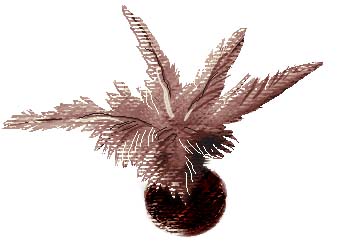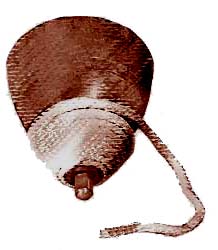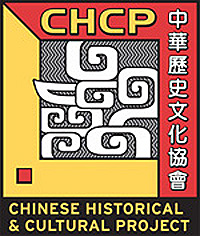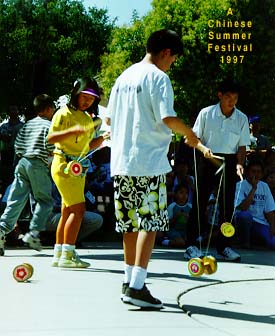|
- Home
- Traditional Chinese Games
Traditional Chinese Games
Source:Chinese Folk Arts: Numbers 4003, 4005 and 4006 Published by the The Overseas Chinese Library |
||
|---|---|---|
| Chinese Yo-Yo | Kites | Jump Rope |
| Shuttlecock | Top | Two-Person Stride |
Source:CHCP's Golden Legacy Curriculum |
||
| Catching Seven Pieces | Pickup Race | Chinese Checkers |
| Shuttlecock | Throwing the Square | Catch the Dragon's Tail |
| Fingers Out | Tsoo! Tsoo! | Fist-Slinging or Fist-Matching |
| Lame Chicken | Forcing the City Gates | Cat and Mouse |
| Land Creatures and Sea Creatures | Round and Round | Chinese Ball |
| Four Seasons | ||
American Equivalents of These Games
Chinese Yo-Yo or Pull-Bell
The bamboo “empty bell” is described in Records of Scenes at the Capital from the Ming Dynasty (1386-1644 A.D.):
“The two ends are round saucer shapes. In the middle is a horizontal piece of wood. Mount it on a string and twirl with a vibrating motion. It emits a humming sound.”
This was a game played by boys and girls in the spring, “when the willow leaves turns green.” It became particularly popular in the North. There is even a poem about it:
Cut bamboo in the shape of a hip drum.
Pull both ends of the string slowly, gently!
When the wind blows, it spins like rushing water.
In the mountain temples, the sound of bells can be heard.
This describes the single-bell form, which looks like a top with a handle. The double-bell looks like two wheels on an axle.
Pull-bells also differ in the sounds they make. The pitch is determined by the number of holes in the pull-bell. The size and thickness also affect the sound. The large diameter of “vibrating bells” produces a “wong-wong” sound. Bells with small sound holes are called “echo-bells.”
Expert players can do tricks like “A Wild Goose Lands on the Flat Beach” and “The Golden Cicada Casts off Its Shell.” As you might expect, “Rise Upward to the Blue Clouds” involves tossing the ball a yard or more into the air.
 Kites
Kites
There are many folks tales about the origin of the kite. A Sung Dynasty commentary puts their first appearance in the Warring States period. But Lin K’un of the Yuan Dynasty believed that the kite was invented in the Han Dynasty to unsettle the enemy by the eerie sounds of attached whistles. History records that the kite was also used to signal for help. One theory has the kite invented during the Five Dynasties period (907-959 A.D.) and brought to Europe by Marco Polo in the late 13th century.
In Taiwan, kite flying is associated with autumn. Split bamboo, which is light and strong, is the traditional material for making the kite frame. There are hundreds of kite shapes including the centipede and giant dragon kites.
 Jump Rope
Jump Rope
The jump rope goes back at least 1,500 years in China. It was called “jumping one hundred threads” because the rope looked like a hundred separate ropes at it circled in the air. It was popular during the Spring Festival in the South.
Jump ropes can be made of many materials including grass and cotton, and straw and cotton combinations coated with wax. Handles are considered de rigeur for the best turning action. Single and group jumping is popular in China as it is in the West.
 Shuttlecock
Shuttlecock
 The Shuttlecock, evolved from an ancient military exercise. Shuttlecock matches were popular in the time of the Han and T’ang Dynasties (207-906 A.D.). After the Sung Dynasty (960-1279 A.D.) the game was called Chien-tsu, the Chinese word for “arrow” which sounds the same as the word for “shuttlecock.”
The Shuttlecock, evolved from an ancient military exercise. Shuttlecock matches were popular in the time of the Han and T’ang Dynasties (207-906 A.D.). After the Sung Dynasty (960-1279 A.D.) the game was called Chien-tsu, the Chinese word for “arrow” which sounds the same as the word for “shuttlecock.”
The shuttlecock consists of a small, weighted circular base with feathers or tassels at one end. It is generally kicked with the toe, heel, instep and inner and outer side of the foot as well as the knee. The kick is from a jump rather than a stationary position.
Two levels of the game are called the “Lesser Accomplishments,” which calls for kicking with one foot, and the “Greater Accomplishments,” which use both feet. Tricks require the use of other parts of the body. “Ivory Chopsticks” calls for catching the kicked shuttlecock between two fingers.
This was a cold-weather game, since the vigorous exercise warmed the body. In 1975, the Taiwanese government included shuttlecock in the elementary school physical education program, which revived its popularity.
See Also: Shuttlecock from CHCP’s Golden Legacy Curriculum for making and playing with a shuttlecock.
 Top
Top
 The top in China can be traced back as far as the Sung Dynasty (960-1279 A.D.), when its forerunner was a 4-inch ivory disc called the “ch’en-ch’ien” which served as a pastime by court ladies. “Tuo-luo,” the word for top, is first found in records of the Ming Dynasty (1386-1644 A.D.), when it was played by children when “the willows bud in early spring.”
The top in China can be traced back as far as the Sung Dynasty (960-1279 A.D.), when its forerunner was a 4-inch ivory disc called the “ch’en-ch’ien” which served as a pastime by court ladies. “Tuo-luo,” the word for top, is first found in records of the Ming Dynasty (1386-1644 A.D.), when it was played by children when “the willows bud in early spring.”
Some tops are spun by means of a string wound around the base. The string is pulled sharply as the top is thrown forward. A small whip is used with some to maintain a continuous spin.
Tops come in a variety of sizes and materials. Tops are equipped with a sharp metal end to slip other tops apart in top ‘duels’. In this century, giant top, over a foot long and correspondingly heavy, was developed in Ta-hsi village. A rope is used to spin it instead of a string.
 Two Person Stride
Two Person Stride
The Two-Person Stride: a variation of many Chinese two-person games that require cooperation and coordination.
 From the Golden Legacy Curriculum
From the Golden Legacy Curriculum
Catching Seven Pieces
Number of Players: Two or more; indoors or out. This game is similar to ‘Jacks’.
Formation: Players stand at a table or are seated on the ground or floor.Equipment: Seven small cloth bags about one inch square. Fill with sand or rice.
Procedure:
- Players take turns.
- A player holds all seven pieces in her/his right hand. She/He drops them on the table (or ground), being careful to spread them out so that no two are touching.
- She/He picks one of the pieces up, tosses it in the air, quickly grabs another from the table, and catches the one tossed into the air before it falls back to the table. The player continues to grab the others from the table in a similar fashion until she/he holds all seven in her/his palm.
- The player should retain the previous ones in one hand while throwing up another piece and grabbing the next one.
- Allowing the piece which has been tossed into the air to drop back to the table, or touching or moving the other pieces on the table except for the one being grabbed, forfeits the player’s turn.
Pickup Race
Number of players: Two to eight. The game may be played by teams, indoors.
Equipment:- One pair of chopsticks and two bowls for each player. These bowls, one for each player, are placed on tables or chairs 8-10 feet apart.
- Four or five marbles for each player. These marbles are placed in the remaining bowls at one side of the room. (For inexperienced players, substitute marshmallows, popcorn or nuts for the marbles.)
- At the signal to go, each player tries to pick up the marbles in her/his bowl with chopsticks and carry them to her/his second bowl on the chair.
- The first one to successfully fill her/his second bowl wins the game.
- The players must pick up the marbles one at a time.
- Hands are not allowed to touch the marbles.
- If a player drops a marble, she/he must pick it up, put it in the original bowl, and start again.
Equipment:
- A checker-board can be made of beaver-board, cardboard or three-ply. The game is played on a six-pointed star. Paint each point of the star a different color and then shellac the entire board.
- Each player has ten ‘figures’ in her/his point of the star. These figures may be disks cut from old mop handles or half-inch dowels, sandpapered to a smooth finish and painted in the colors corresponding to those on the board. (Holes may be bored at the intersections and marbles or pegs used instead of disks.)
- The figures are placed on the intersections, beginning with the point, so that they are placed in rows of 1, 2, 3, etc.
- Each player tries to get her/his figures across to the opposite star point. He/She may move one space at a time in any direction except backward by moving in a straight line to an open space.
- Jumps may be made of one figure at a time to an empty space, as in checkers. No man is removed from the board. A series of jumps may be made; often a player gets a “ladder” set up by which she/he jumps all the way across the board.
- No jumps or moves may be made backward into an opponent’s point.
- Three players can play the game using alternating star points for starting points, using fifteen figures for each player.
Shuttlecock
This is an interesting game for all age groups. Many of the Chinese develop considerable skill in playing it.
Number of players: One to twenty
Equipment: A shuttlecock, which may be made of four chicken feathers and a piece of thick cardboard.
- Cut out a circular piece of cardboard about one and a quarter inches in diameter.
- Paint it with cardboard or tempera paint.
- Attach the four feathers in place with a piece of cellophane glued to the cardboard disk.
- A piece of metal, such as a bolt washer, can be added to give the shuttlecock some needed weight.
- The player tosses the shuttlecock into the air and then kicks it with her/his foot back into the air. Players continue this as long as they can without missing or allowing the shuttlecock to touch the ground.
- When players become fairly skillful, they kick the shuttlecock not only with the instep but with the knee, or sometimes alternating the heel and instep kicks.
Throwing the Square
Number of players: Two or more (or two teams). Played indoors or out.
Equipment:
- A rectangle, approximately 12 X 24 inches drawn on the floor or ground, divided into two equal squares.
- A disk (coin, flat rock or a washer) for each player.
- One player places her/his disk in one of the squares. The other player stands on a line about 8-10 feet away from the rectangle. From this point Player One tosses the disk at the squares.
- If the disk lands in the square containing the other player’s disk, Player One scores two points. If it lands in the vacant square, Player One scores one point. If it lands outside the rectangle, Player One scores nothing.
- Players take turns in tossing the square. The player with the highest score is the winner.
Catch the Dragon’s Tail
Number of players: Ten or more. Played outdoors.
Formation: All players stand in a line, their hands on one another’s shoulders. The first person in line is the head of the dragon, and the last is the tail.
Procedure:
- The head tries to catch the tail by maneuvering the line around so that she/he can tag the end player. The line must not break.
- All the other players do their best to keep the head from catching the dragon’s tail.
- When the head catches the tail, all players move forward one position while the player who was in front as the head now becomes the tail.
 Fingers Out
Fingers Out
Number of players: Two. Can be played anywhere.
Procedure:
- Two players face each other.
- They count,“one, two, three!” and on “three” they put out their right hands, closed or with one or more fingers extended and at the same time shouting out some number.
- The player who guesses the correct number of the sum total of fingers extended, or the nearest to it, scores a point.
- Five points may constitute a game.
 Tsoo! Tsoo!
Tsoo! Tsoo!
Number of players: Four or more. Played outdoors.
Procedure:
- One player is blindfolded; the remaining players are ‘chickens’.
- The blindfolded player says “Tsoo ! Tsoo !’ – (meaning, “Come and seek your mother.’)
- The chickens run up and try to touch the blindfolded player without being tagged.
- The tagged player becomes the blind man.
 Fist-Slinging or Fist-Matching
Fist-Slinging or Fist-Matching
(Chinese name literally means ’throwing fists”)
Procedure:
- One player acts as ‘caller’. She/He wins or loses accordingly, and may take as many tries as has been determined. Or the players may simply take one turn at a time.
- The caller calls out a number from 0-10 (if two are playing).
- This call is made just as each player “throws her/his fist,” holding up any number of fingers as she/he desires.
- If the sum of the fingers on the two fists is the amount called, the caller wins. If not, the caller loses.
- If three persons play, there will be three fists and therefore a possible total of 15 fingers. For 4 players, there will be a possible 20 fingers, etc.
- The caller must call a number that will come within the total number of fingers that may be extended.
- The caller may use names or other substitutes for actual numbers, i.e. she/he may shout “Joe, Jim, Tom,” meaning 3; or “Jack and Jill” meaning 2; or “double-fours” meaning 8; or “one week” meaning 7.
- The Chinese often call the names of places, lines of poetry, famous persons in history, etc. This adds great subtlety and humor to the game and calls for quick and witty thinking.
- All calls must be made to synchronize exactly with the throwing of the fingers so that no player can adjust her/his fingers in order to win.
 Lame Chicken
Lame Chicken
Number of players: Two or more. Indoors or out.
Equipment:
- Each of two players, or of two teams, has ten sticks which are 10″ or 12″ long.
- These sticks are arranged in a row about 10″ apart like rungs on a ladder, one row for each team.
Procedure:
- One player (‘lame chicken’) must hop over these sticks without touching any of them. Touching a stick disqualifies the player.
- After hopping over the last stick, still on one foot, the player reaches down and picks up the stick.
- She/He then hops back over the remaining sticks.
- Dropping the stick, she/he then hops over the nine remaining sticks, picks up the ninth stick, again hopping back over the remaining sticks.
- This continues until all of the sticks have been picked up.
- A player is disqualified if she/he touches both feet to the ground or if she/he touches a stick with her/his foot.
- The winner is the player, or the team with the most players, finishing without mistakes.
Variations:
- The game may be run as a race. A player who fouls must start over.
- It may be used as a relay. The first player hops over ten sticks, returning with the tenth. The second man hops over nine, the third hops over eight, etc.
- The ‘lame chicken’ may change by hopping on the alternate foot every other round.
 Forcing the City Gates
Forcing the City Gates
Number of players: Ten or more. Played outdoors
Procedure:
- Two lines each with an equal number of players, 10′-15′ apart. Each team has a captain.
- Players in each line hold hands. A player runs out from one side and dashes with all her/his force against the hands of her/his opponents. If she/he breaks through, he has to join her/his opponents.
- Then a player from the other side attempts to ‘force the gates’. This continues until one side has no players left.
 Cat and Mouse
Cat and Mouse
Number of players: Ten to thirty. Played outdoors.
Procedure:
- Make a circle, with all but two players holding hands. One of those players is the cat, who stands outside the circle. The other is the mouse, who stands inside the circle.
- The circle of players revolves around the mouse.
- When it stops, the cat darts in at one side and the mouse goes out the other. The cat pursues the mouse, but she/he must follow exactly the path the mouse has taken, with no short cuts.
- The two wind in and out of the circle until the mouse is caught.
- Then two more players are chosen, or the cat may become the mouse and a new cat may be chosen.
 Land Creatures and Sea Creatures
Land Creatures and Sea Creatures
Introduction: Landscape in China is fabulous. Children in China appreciate the beauty of their native land; they write simple poems and play games of what they see and hear on the land and in the sea.
Number of players recommended: Twelve to twenty
Procedure:
- Two leaders are selected. Each then chooses a name of a popular fruit or candy for himself that would attract the attention of other children to him, i.e. Leader A is a banana, and Leader B is a pineapple.
- The leaders then form an arch with their arms, and the rest of the children form a single line (each child putting her/his hands on the shoulders of the one in front of him).
- Then they sing “A Bird is Falling Into the Water” to the tune of “London Bridge is Falling Down”, and pass through the arch along the way.
- Just as the song ends, the leaders capture the one who is passing under the arch. The one who gets caught is asked to choose between banana and pineapple.
- If banana is chosen, the player belongs to Leader A. If pineapple is chosen, the player belongs to Leader B.
- Repeat the song until all members are divided into A and B teams.
- After the teams are divided, the leaders decide by flipping a coin, what they will be – land creatures or sea creatures. If Team A is land creatures, each member will receive a name of a creature found on the land, varying from wild animal to domestic pets, and from vegetables to rolling stones. The other team will receive names of sea creatures from whales to starfish. (NOTE: The names of Team A’s creatures will be a secret to Team B, and vice-versa.)
- When each member has a code name, leaders A and B will do the Rock, Paper, Scissors game. If Leader A wins, she/he then selects a member from Team B and blindfolds him, then sings the rhyme “Wave your hand, then stop, tonight I will send you a soup of cod, [code name].” (Inserts the code name of one of her/his team members).
- The member from Team B is now released with blindfold removed, and asked to guess who has the code name sung in the rhyme. If the guess is wrong, then Team B member will be taken away and now becomes a member of Team A. If the guess is correct, then the code-named member is captured by, and becomes a part of, Team B and is given a new name.
- These procedures are repeated until one team captures the greatest number of players.
 Round and Round
Round and Round
Number of players: The entire class forms a circle.
Procedure:
- A large circle symbolizing a moon cake is drawn on the ground. This circle is divided into 12 sections, and each section is given a different number.
- The class is then divided into three groups. Each group chooses a leader.
- In turn, the leader of each group takes a member of her/his group into the center of the circle.
- This member is blindfolded, spun around four times and then allowed to take four steps in any direction.
- She/He is then given the score of whatever section in which she/he lands.
- When all the players have had their turn, the team with the highest score wins.
 Chinese Ball
Chinese Ball
Equipment: A basketball
Procedure:
- The players stand shoulder to shoulder in a large circle.
- One player has a basketball which she/he throws to any player in the circle who must try to catch it.
- When the ball is caught by a player, children on either side must raise their arms in the following manner: The player on the catcher’s right will raise her/his left arm, and the player on the catcher’s left will raise her/his right arm.
- If a player raises the wrong arm, or neither or both, that player leaves the circle.
- If a player fails to catch the ball, she/he too must leave the circle.
- If the player catches the ball, she/he throws it instantly to some other player, whose neighbors must raise their arms as described above.
- The upraised arms are lowered again as soon as a catcher has thrown the ball.
- When all but five players are eliminated, the remaining players are the winners, and the game starts all over again.
 Four Seasons
Four Seasons
Introduction: This is a game to help the children learn about the four seasons. Either English or Chinese may be used in this game. Whichever language is chosen, it must be used consistently throughout the game.
Number of players recommended: Entire class
Procedure:
- The children are taught the names of the four seasons.
- Teacher chooses one child as the leader who will give directions and keep score.
- Divide the rest of the class into teams of four members each: Spring, Summer, Autumn and Winter.
- All the teams sit in a circle. Each member sits according to the seasonal order as above.
- The game begins with the leader saying, “I am Spring. I am leaving now.” The children who are ‘Summer’ stand up and say, “I am Summer. I am coming.”
- The leader has to watch and listen carefully. If a player stands at the wrong time, does not stand when she/he should or uses the incorrect season, her/his team does not get a point. If a player does everything correctly, her/his team gains a point.
 American Equivalents of These Games
American Equivalents of These Games
Discuss the names of the games in this unit. Compare them to similar American games:
- Catching Seven Pieces = Jacks
- Pickup Race = Spoon & Egg
- Throwing the Square = variation of Shuffleboard
- Fingers Out = variation of Rock, Paper, Scissors
- Tsoo Tsoo = variation of Blind Man’s Bluff
- Fist-Slinging = variation of Rock, Paper, Scissors
- Lame Chicken = variation of Hop Scotch
- Forcing the City Gates = Red Rover, Red Rover
- Land Creatures = variation of Ring Around the Rosy
- Round and Round = variation of Blind Man’s Bluff
- Dragon’s Tail = In & Out the Window



